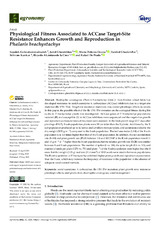Physiological Fitness Associated to ACCase Target-Site Resistance Enhances Growth and Reproduction in Phalaris brachystachys
Autor
Golmohammadzadeh, Sajedeh
Gherekhloo, Javid
Osuna, María Dolores
Ghaderi-Far, Farshid
Kamkar, Behnam
Alcántara-de la Cruz, Ricardo
Prado, Rafael de
Editor
MDPIFecha
2022Materia
Acetyl-coenzyme A carboxylaseIle-1781-Thr mutation
Plant growth rate
Resistance pleiotropic effects
Seed production
Short-spike canarygrass
Weed management
METS:
Mostrar el registro METSPREMIS:
Mostrar el registro PREMISMetadatos
Mostrar el registro completo del ítemResumen
Short-spike canarygrass (Phalaris brachystachys (Link.)) from Iranian wheat fields has developed resistance to acetyl-coenzyme A carboxylase (ACCase) inhibitors due to a target-site mutation (Ile-1781-Thr). Target-site resistance mutations may confer pleiotropic effects in weeds. In this paper, the possible effect of the Ile-1781-Thr mutation on the ecological fitness during life cycles in P. brachystachys plants was investigated. ACCase genes of P. brachystachys populations resistant (R) and susceptible (S) to ACCase inhibitors were sequenced and the vegetative growth and reproductive characteristics of the plants were assessed. In the final growth stage (217 days after planting—DAP), R sub-population plants were 30 cm taller than the S plants. Additionally, the R sub-population produced up to 12 leaves and 2.8 tillers more per plant, and accumulated double the dry weight (2850 g m−2) compared to the S sub-population. The leaf area index (LAI) of the R sub-population was 1.1 times higher than that of the S sub-population. In addition, the net assimilation rate (NAR) and plant growth rate (PGR) between 114 and 182 DAP of the R sub-population were 0.11 and 13 g m−2 d−1 higher than the S sub-population, but the relative growth rate (RGR) was similar between R and S sub-populations. The number of spikes (6 vs. 3.8), the spike length (8.4 vs. 5.5), and number of seeds per plant (1276 vs. 751 seed plant−1) of the R sub-population were higher than the S ones, but the weight (3.25 g) and size (11.6 mm2) of 1000 seeds were similar between populations. The R sub-population of P. brachystachys exhibited higher plant growth and reproductive parameters than the S one, which may increase the frequency of resistance in the population in the absence of adequate weed-control methods.

